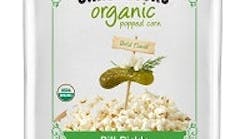Market channels and where and when we snack are also changing. Conservatively, snacks are eaten at least once a day by nearly 83 percent of Americans in 2016, versus 73 percent in 2014, according to research from Technomic. Roughly 53 percent of consumers say they snack between meals, compared with 41 percent in 2014, the research finds.
"Consumers’ lives are busier, so snacks are serving more needs than in the past," notes Kelly Weikel, director of consumer insights at Technomic. "To gain share, snacks must adapt to meet consumers’ wide range of needs — from tiding them over to the next meal to replacing meals to providing nutritious, supplemental treats."
Technomic's 2016 snack report goes on to say younger consumers drive on-the-go snacking. Forty percent of snacks are consumed away from home. Consumers want satiety and tasty flavors but, most importantly, favor more nutritious options and "better-for-you" ingredients.
Innovation is more targeted, and product variety and kids' snacks are greatly impacting snack choices, explained Sally Lyons Wyatt, executive vice president & practice leader for client insights at IRI Worldwide, Chicago, during a recent webinar on the State of the Snack Industry.
"The snacking universe is still vast, mini meals are occurring across the day and life stages and wellness plans impact snack choices," she said. "Millennials and boomers are the biggest drivers of growth, and the role of snacking varies. Retail dollar growth of snacks is up 2.9 percent versus a year ago, but growth of foodservice snacks, at 3.9 percent, is outpacing retail," she noted. "Refrigeration was a clear theme in 2015, pointing toward the quest for fresh."
[pullquote]
She predicts 2016 opportunities in:
- The kids segment, because households with kids snack more frequently in larger quantities
- Product varieties
- Wellness and clean ingredients
- Shifting purchase channels
- The internet's gain in penetration
"Consumer attitudes and behaviors are opening up additional growth opportunities, including those for natural/organic products, and opportunities will be abundant," she summed.
Snack time all the time
What's more, there's no bad time for a snack. NPD Group says snack foods consumed during a meal are inspired by items already in the house, and times of day factor into whether consumers will go for certain foods and beverages. Evening hours prompt stressed snackers to munch more on sweets like candy, chocolates and ice cream. We tend to reward ourselves at these hours, which shows how emotionally involved we are with sweets, NPD adds.
In the afternoon, savory snack foods such as chips, pretzels, meat snacks and nuts come into play, many of which are consumed alongside or prior to main meals.
Snack foods with better-for-you claims perform best earlier in the day. Sugars − topping the list of foods to avoid − are easier to ignore earlier in the day. Marketers wonder if they should reformulate products to use sugar alternatives to attract consumers during earlier day parts, NPD points out. "The fact that we're seeking more natural or 'clean' ingredients, the best action may be to win with consumers when they're most willing to consume the sweet foods they already love."
Likewise, Packaged Facts sees a strong ready-to-eat popcorn/caramel corn market, with alternative non-potato chips leading the salty snack segment in 2015 sales. Both RTE popcorn and non-potato chip categories can be better for you, and provide a modicum of indulgent satisfaction most snackers still crave, says the company's "Salty Snacks Report, 4th Edition."
The salty snack category in 2015 also saw a proliferation of flavors hitting store shelves, from Tom Yum soup-flavored pretzels to sweet-and-salty combinations on potato and tortilla chips. The salty snack market should hit $27 billion by 2020, the report says. Potato chips are still the top revenue generator, despite challenges from ready-to-eat popcorn and caramel corn and alternative fruit and vegetable chips.
Mid-day munchers and evening snackers alike might want to check out new Popchips Ridges from Popchips, Playa Vista, Calif. The thick-cut chips have 72 percent less fat and 55 percent fewer calories than conventional ridged competitors, Pop Chips says, but are crispy, crunchy and come in four flavors. They also use about one tablespoon versus a cup of oil in regular chips, and will roll out nationwide in June.
Globally, the pretzel market is seeing steady growth due to more healthy pretzel versions in a range of flavors, and coming from more brands, especially private labels. Technavio analysts' latest report indicates the global pretzel market should exceed $7 billion by 2020, growing at a compound annual growth rate (CAGR) of more than 2 percent.
"The demand for healthy snacks and rising disposable incomes will support the steady growth of the global pretzel market during the forecast period," states Vijay Sarathi, lead analyst at Technavio for food research. The Snyder's of Hanover brand alone achieved sales of $434 million last year for parent Snyder's-Lance. The company just launched the indulgent S'mores Sweet and Salty Pretzel pieces, but is also introducing 50 percent-less-fat Pretzel Pieces in two savory flavors: Ranch and Everything.
Popcorn's still poppin'
Innovative flavors such as smoked paprika, maple and dill pickle as well as clean-label ingredients are helping popcorn brands like Skinny Pop maintain strong sales. Thomas Ennis, president and CEO of brand owner Amplify Snack Brands, Austin, Tex., says SkinnyPop is broadening distribution and market share with several new flavors, and the company will nationally debut Paqui tortilla chips soon.Angie's Boomchickapop announced a sweet barbecue popcorn in March. G.H. Cretors, Waukegan, Ill., which touts simple, "no artificial" ingredients, unveils organic popcorn in Dill Pickle and Chile Jalapeno White Cheddar flavors.
Boulder Canyon Authentic Foods' new low-calorie/less-fat Real Thin Pop popcorn features premium olive, avocado and coconut oils and seasonings applied by a "revolutionary" method that differs from traditional tumble mixing.
Quinn Snacks, Boulder, Colo., describes new Cheddar and Sea Salt microwave popcorn as a "classic snack, re-imagined with farm-to-bag transparency." Other flavors include Super Curly Kale, White Cheddar, California Olive Oil and Classic Sea Salt. "Knowing where your food comes from is fundamental, and it’s about time snack companies open up," says founder and CEO Kristy Lewis Quinn No GMOs, artificial flavorings, preservatives or "unpronounceables" are used in Quinn's snacks.
Not so sweet
Sweet baked snacks aren't faring as well because people are favoring healthier options without sweeteners. But if consumers indulge, they'll go for single-serve baked goods, Packaged Facts points out. The growth rate of sweet baked goods hit $20 billion in 2014, but the firm says this will level off and hit only $23 billion by 2019. Some baked goods companies are responding by revising products to incorporate more protein, fiber and "real" ingredients, the findings say.
The removal of artificial colors and flavors, high-fructose corn syrup and partially hydrogenated oils are leading the charge to better-for-you, sweeter snacks. The movement is exemplified by the recently reformulated SnackWell's cookies, Quaker's new Breakfast Flats midmorning snack bars and Otis Spunkmeyer's new retail baked goods line (Spunkmeyer's is flagged with "no funky stuff" on the label).
In March, free-from food producer Enjoy Life Foods, Schiller Park, Ill., now owned by Mondelez, debuted bite-sized, allergy-free protein bites called ProBurst Bites, a creamy chocolate center rolled in crunchy seeds and spices. Featuring non-GMO ingredients, the bites come in mango habanero, cranberry pomegranate and cinnamon spice chocolate flavors, with at least 6g of plant-based protein per serving.
Meat snacks are surging. They meet consumer needs for a perceived health benefit by being a good source of protein, and most tend to be low in fat. According to a 2015 snack report from Mintel, the category is worth more than $1.3 billion, and U.S. jerky sales rose 12.5 percent in 2015 alone. Jack Link's line expansions include its new portion-controlled, bacon-filled Squatch Loaded snack sticks and Maple Bacon Jerky No. 10.
Meat snack bars are a new subcategory; they're soft and chewier than jerky. Boulder, Colo.-based Wilde Snacks, offers chicken and turkey bars that are baked not smoked, cured, fried or dried. Krave, which was acquired last year by Hershey, will launch a meat bar in August and is working on a snack bar with fruit and quinoa, as well as meat.
Vermont Smoke & Cure, South Barre, Vt., is rolling nationally into Target stores with a line extension of small, half-ounce, lower-sodium/lower-fat meat sticks in portable six packs. The company's research showed families want protein-filled snacks they can tote with them on trips, after school and to various outings.
Several brands – including Oscar Meyer, Hormel and Tyson -- have developed protein snack packages mixing meats with cheese, nuts and other filling ingredients. Sargento Foods recently took off on a tangent, skipping the meat but mixing cheese, fruit and nuts in snack kits called Balanced Breaks.
Snyder's-Lance, Charlotte, N.C., continues to bring out easy-to-eat snacks across several of its brands with new flavors and more gluten-free, better-for-you and on-the-go options. "Consumers have less time to sit down for big meals," observes Rod Troni, chief marketing officer. "With our recent acquisition of Diamond Foods, our total company will have even more innovation in the future, including new items from Kettle Chips, Kettle Brand, Pop Secret, Emerald and Diamond of California," he says.
Thin is in
Thin, crispy cookies and crackers -- such as Mary's Gone Crackers Organic Thins, Mondelez's Oreo Thins and Archway Gluten-Free Cookie Crisps from Snyder's-Lance -- help satisfy, and we can eat more of them for fewer calories. In March, Deerfield, Ill.-based Mondelez nationally launched Nabisco Good Thins, what it claims is its first new snack brand in more than a decade. The crackers are made with potato, chickpeas or rice, and are baked without artificial flavors, colors, cholesterol, partially hydrogenated oils or high-fructose corn syrup. The potato versions have 60 percent less fat than "leading regular potato chips," while the rice variety is gluten-free.
Many vegetable-based snacks are extruded, notes Brian Armstrong, senior director of innovation and R&D at Bunge North America, St. Louis. In direct extrusion, Bunge combines grain-based ingredients with water under pressure to make ready-to-eat air-puffed foods. "Expectations for balanced nutrition and quality ingredients have increased. Air-popped extrusions are on-trend in the realm of healthier snacks, delivering a crunchy snack made with trending ingredients—with pellet extrusion, we’re using red pepper, orange zucchini, kale, spinach, legumes, chia seeds, and more."
Despite so many new products entering the market, Technavio says the great demand for convenient, healthier versions will only gain momentum as more product opportunities develop in more venues (online shopping, changing lifestyles, private-label brands).


